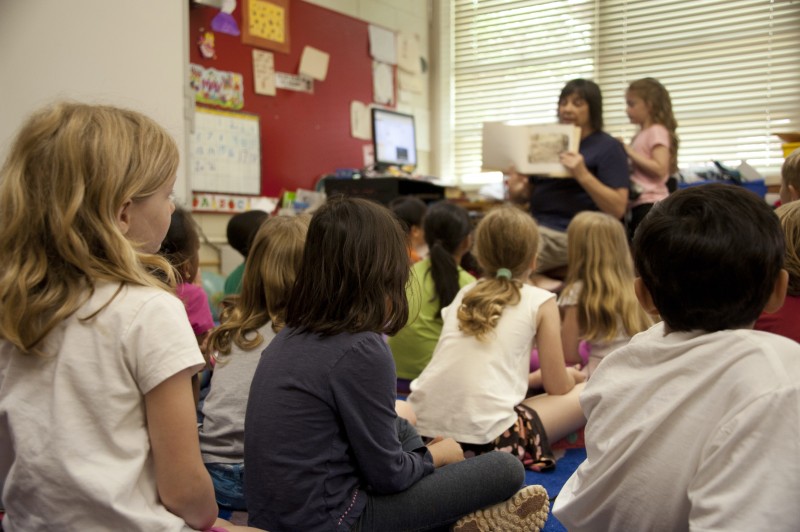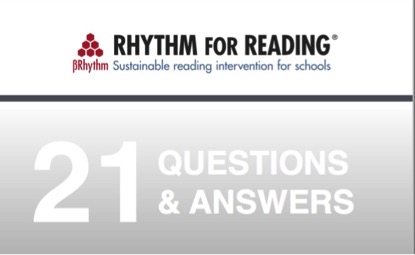The Rhythm for Reading blog
All posts tagged 'Learning'
How we can support mental health challenges of school children?
11 October 2023
The waiting lists for local child and adolescent mental health services- ‘CAMHS’ are getting longer and longer. Teachers and parents are left fielding the mental health crisis, while the suffering of afflicted children and adolescents deepens with every day that passes. Young people’s mental health challenges cannot be left to fester, as they affect their identity, educational outcomes, parental income and resilience within the wider community. Here are 10 key strategies that parents and teachers can use to support children and adolescents dealing with distressing symptoms of mental health challenges while they are waiting for professional help.
1. A calm educational environment
The size of the school seems to determine the quality of the learning environment to some extent. If every class takes place in a tranquil atmosphere, this means that every teacher takes responsibility for the ambience in every lesson. In ‘creative’ subjects such as music, art and drama, it is particularly vital that children participate in lessons where respect both for learning and for every student is maintained. An ethos of respect for every student is easier to sustain in a calm atmosphere. Children with mental health challenges are more likely to cope for longer in this setting, where they are better able to self-regulate any difficult feelings that may arise.
2. A space to talk
In a school it is important that teachers and children have spaces where they are able to discuss and resolve pastoral or academic challenges in privacy, rather than for example, in the middle of a busy corridor. This is incredibly important for the more vulnerable pupils in our communities. Those with special educational needs and disabilities need to be supported with a particular focus in terms of social, emotional and mental health. A place where children are able to ask for help or advice from the pastoral team immediately shows all pupils that this is a caring school that values their feelings, responds to their questions and most importantly, takes their mental health challenges seriously.
3. Listening from the heart
The pressure of workload on teachers is enormous, and yet according to research, teachers are more effective in the classroom when they not only show their passion for the subject, but also that they care deeply about the children they are teaching. Both these factors unfortunately can lead to teacher burn-out, which would obviously diminish their capacity to listen from the heart.
Arlie Hoschild’s ’The Managed Heart,’ discusses ‘emotional work’ as an integral but undervalued and unrecognised aspect of many public-facing roles.
Teaching is clearly one these, requiring intense and constant emotional input. Sadly, many of the best and most dedicated teachers suffer because they are so invested in pupils’ learning and personal development.
It is vital that school leaders cultivate an environment that values the well-being of teachers, protects them from abuse, prevents them from burning out and avoids unnecessary workload. Teaching can be incredibly fulfilling, but often feels all-consuming. It is therefore vital that teachers have realistic and sustainable workloads. Our teachers deserve to have time to recharge during the school day so that they are better able to support pupils’ mental health challenges, particularly if they work as part of a pastoral team.
4. Compassionate reassurance
Much has been said about empathy in recent years, but compassionate reassurance achieves a stronger outcome in less time. Compassion involves complete acceptance of the situation, as well as the capacity to hold all the challenges of that situation in mind, which is why it is easier to help students to feel emotionally ‘safe’, as they are more likely to begin to self-regulate. This involves being able to breathe deeply and slowly, feel physically more relaxed and more connected to their body, which may enable them to be better able to express their feelings and to share their concerns more openly.
5. Offering quality time with no distractions
Imagine a nine year old child, overwhelmed by a challenging situation and dealing with a mental health challenge, such as acute anxiety. One day, they feel ready to trust a teacher, to open up and to disclose their concern, but to their disappointment, the teacher must rush away to deal with something rather ‘more urgent’.
Their rational response would say, ‘Yes, emergencies happen, but my feelings are not as important as an emergency.”
At the same time, their vulnerable feelings might achieve a ‘shut down’ in their central nervous system and a dread of abandonment or rejection could trigger an acute attack of panic or anxiety or other distressing feelings and thoughts.
It is important for the child that the teacher stays physically present with them until that conversation or connection has reached a mutually agreed end point. If not, a negative spiral can quickly gain momentum if the ‘end’ of the conversation or connection feels abrupt or unplanned.
6. Practising gentle kindness
In day to day life, if we practise gentle kindness, it is obvious that we are not interested in conversations that are unkind. By walking away, we are showing that unkind remarks are not taken seriously. Gentle kindness begins in the mind, replacing judgmental thoughts with compassionate ones. It is arguably far easier to prevent mental health challenges than to treat them. Gentle kindness is a strong starting point for effective prevention.
7. Honouring the feelings
We all have feelings. Most people are uncomfortable with accepting all their feelings because difficult emotions such as shame or guilt or a belief that they are ‘not enough’ are pushed under the rug and barely acknowledged in our society.
Children and young people make comparisons between themselves and an ‘ideal’ version that they have seen online or experienced through parental scripting.
Here are a few examples of parental scripts or expectations of their child:
- To get married and have children
- To support the same sports teams as their parents
- To attend a certain school or university
- To take on the family business or join a certain profession
- To live in a particular geographical area
Sometimes this form of scripting is very ambitious and the child is expected to achieve one or several of these:
- To qualify to represent their country in an elite sports team or even in the Olympics,
- To win a scholarship to a particular school or university
- To have top quality examination results
- To break records or ‘be the first’
- To become so special and so talented that they are recognised for their accomplishments.
If these expectations are not fulfilled, harsh self-judgments and self-criticisms are likely to follow.
All of these negative beliefs, thoughts and feelings may well become so toxic that they may have a detrimental effect on the individual.
Conversely, a child who has too little support or stimulus from their family may well feel neglected and frustrated by a lack of attention and display challenging and self-pitying behaviour.
It is important to protect children from creating idealised versions of themselves. Even conscientiousness, which is often encouraged at school and is intrinsically admirable rather than harmful, can develop into an unhealthy source of anxiety and low-self-worth in certain situations.
8. Expressing the emotions
To express anger, frustration or resentment appropriately is natural and necessary. An outlet for emotions can be through sport or dancing or even music and singing. Some writers claim that anger has fuelled their best work! The response to these emotions has been carefully honed by warrior disciplines where the balance of managing and harnessing energy is the product of many years of dedicated training - for example Samuri warriors who are taught not only combative skills but also flower arranging. Cultures all around the world have found different ways to manage and express emotion in a socially accepted way. All of these practices involve allowing the body to discharge the emotions, as this is healthy.
Insufficient access to the creative curriculum means that pupils are restricted in terms of self-expression, the development of executive function, personal development and critical thinking. One appropriate way to express emotion is to dance and move, or sing and play music, allowing the body to cast off all the explosive, the aggressive and fiery feelings. Another way is to write down how these emotions feel and to really vent this on the page. These forms of physical release are very cathartic, though this needs to be done in a place, ideally out in nature - or where others won’t be disturbed!
9. Sharing worries and concerns
Young people and their parents need to share their challenges, worries and concerns. If a young person’s mental health challenges start to spiral and the situation deteriorates suddenly, this needs a swift and orchestrated response from everyone with a duty of care. It is not enough just to prioritise the children’s development of topical concepts such as, ‘resilience’, ‘growth mindset’ and ‘perseverance’. Above all, young people should not be left feeling isolated and surrounded by adults who are uncertain about what they ought to do, when facing a child who feels seriously overwhelmed, depressed or anxious.
Charities run helplines, manned by volunteers, and they train their people to offer a compassionate listening service. No one needs to suffer in isolation while they wait for professional help. As well as pastoral teams and family liaison workers in schools, there are helpline volunteers who work for charities that exist outside school. Together we can make sure that we support the families coping with child and adolescent mental health challenges every day.
10. Helpline numbers
Family Lives: 0808 800 2222
The Samaritans: 116 123
Childline: 0800 1111
NSPCC: 0808 800 5000
In an emergency dial 999.
Did some of this post resonate with your own experience?
If so, you might be interested in the important role played by rhythm in the management of stress in these related blog posts:
Education for social justice - This post sets out the mission, values and impact of the Rhythm for Reading programme in terms of reading and learning behaviour.
Rhythm, breath and well-being - This post unpacks the relationship between rhythm, breath and well-being in the context of smaller and larger units of sound, comparing the different types of breath used in individual letter names versus phrases.
Releasing resistance to reading - Discover how self-sabotaging behaviour and resistance to reading can be addressed through a rhythm-based approach.
Rhythmic elements in reading: from fluency to flow - Discover the importance of rhythm in activities that involve flow states and the way that elements of rhythm underpin flow states in fluent reading.
Rhythm, attention and rapid learning
3 October 2022
There are many different forms of attention. Neuroscientists have studied the development of cognitive attention in children as well as the different types of attention that we experience. Boredom and repetition generate a trance-like state of attention, whereas novelty and a switch in the stimulus generate a shift and a rapid reset of attention. The attention span exists to protect us, to feed us and to ensure that our genes succeed us in future generations. This is why the attention span is adaptable and can be trained to become longer or shorter using reinforcements such as rewards or threats. Ultimately, the attention span is involved in predicting when and where the next reward or threat will take place.
If a chid has experienced a threatening situation such as a war zone, they are likely to flinch in response to loud noises and their attention is likely to be highly vigilant, having been trained by the environment to monitor potential threats. A chid raised in a calm and enriched environment is likely to have fostered a natural curiosity for the world around them and to have interacted in reciprocation with it. Conversational turns in such an environment are the rhythmic hallmark of social interactions, and according to researchers contribute to emotional well-being and language development (Zimmerman et al., 2009).
The Rhythm for Reading programme offers an opportunity to move children away from a vigilant state, to a rhythmically responsive form of attention that involves reciprocation and builds receptivity and stamina. The attention system is dynamic and is particularly responsive to setting and emotional set point. If a child was threatened repeatedly at school, for example by a bully, then vigilance in the attention system would affect the child’s learning to some extent.
By the same token, it’s important that Rhythm or Reading sessions take place in the same place, on the same day of the week and at the same time of day to establish the regularity of exposure to rewarding experiences. Knowing where and when positive experiences occur, such as feelings of personal safety, social connection, a boost to well-being, engagement with rewarding patterns and calming breath work, which are nurtured during Rhythm for Reading sessions is important. The anticipation and experience of weekly Rhythm for Reading sessions enables a child’s attention system to recognise the sessions as a ‘real’ part of their environment. A consistent pattern in the children’s lives enables a deeper sense of anticipation and supports rapid learning during the programme.
Zimmerman, E.J., Gilkerson, J.,Richards, J. A., Christakis, D.A. Xu, D., Gray, S., Yapanel., U. (2009) Teaching by listening: The importance of adult-child conversations to language development. Pediatrics, 124 (1), 342-349, doi: 10.1542/peds 2008-2267
Where has all the chanting gone?
2 October 2020

When I watched the announcements about lockdown on March 23rd 2020 from a hard metal seat in Glasgow International Airport, I’d already made ten trips to Scotland and it felt so frustrating that the project would be interrupted when we were so close to its completion. Throughout the lockdown and the summer months, I hoped very much that we would have a chance to salvage and finish off the work. In the past two weeks it has been an absolute privilege to return to the schools with ‘refresher sessions’ and follow-up testing. So much has changed. The teachers vigorously spray, clean and ventilate the classrooms. Everyone is vigilant and determined to keep their community safe. It is obvious that this goal is shared and held dear by all. Even young children immediately take all their books and pencils with them when they sit on the floor while their tables and chairs are disinfected. Absolutely nobody needs to be reminded to do this.
In one of the schools, particular spaces are filled with food and clothing. The leadership team came into the school every single day of the lockdown, as well as throughout the summer months to keep everyone on track; teachers worked face-to-face with the children throughout this period. Stunning new displays made by the parents now explode out from the staffroom walls and thank you cards are pinned to the noticeboard of a beautiful new community room.
Rhythm for Reading has been modified to keep everyone safe. I visit only one school in a single day and wear a mask. The children remain in their ‘bubbles’ when they take part, and stand at least two metres away from me. In between each session, I ventilate and vigorously disinfect the teaching area. Of course, there is plenty of time for cleaning as each Rhythm for Reading session is, as always, only ten minutes in duration. Actually, this level of flexibility fits in very well with the dynamic teaching that I’m seeing in the schools - and the children are loving that they are being taught in small groups and in an increasingly nuanced way.
Robust, energetic chanting has always been an important part of the Rhythm for Reading programme, but chanting, like singing is strictly prohibited. For quite some time I have been resigned to mothballing the programme for this reason. Eventually however, a neat solution popped into my mind. With a bit of experimentation, I realised that it is possible to vocalise safely and precisely, whilst keeping the volume level below that of normal speaking. All that is required to make this modification fun, is a little imagination. Most children know how to squeak like a mouse - these high pitched sounds are made in the throat and involve minimal breath - far less than speech. So, my solution has now been ‘road-tested’ by the squeaky teams in Scotland and I’m happy to have found a safe and new way to offer the programme without diluting it.
I would like to say a huge thank you to these children, teachers and school leaders for the opportunity to come back and complete the programme. It has been utterly inspiring, humbling and uplifting to visit your schools these past two weeks.
A New Wave for Music Education?
2 August 2020
Yes, I’m probably wearing rose-tinted glasses… but as old ways recede, something new always appears.
New creative potential is springing up out of the constraints of COVID because life does that. I am not suggesting that every family is looking for a music teacher right now, but given that we may face a second wave of the virus in the autumn, many parents will be giving thought to how they might structure their child’s home life. This is an opportunity to strengthen musical engagement from the roots up.
Here are ten reasons why a new wave for music education and a new concert-going audience is likely to appear.
1. Children and young people have not taken part in their usual clubs and activities for a long while and need a challenge this autumn.
2. Parents have not spent money on the usual wide range of activities for their children and some are looking for life-affirming, structured activities that can enrich their children’s lives.
3. Parents and children have spent more time together, staving off boredom and frustration. In September, it will be time to start something new.
4. Instrumental music lessons establish weekly goals, a step-by-step approach and a learning gradient that is tailored to each individual child.
5. Instrumental music teachers guide parents by explaining how best to support their child’s daily music practice.
6. There’s more time to practise musical instruments and many music teachers have seen accelerated progress in recent months.
7. Remote teaching can be a little challenging, but it does work well and it’s more convenient in many ways as parents save time and money in terms of travel; remote teaching also helps to keep the air cleaner for this reason.
8. There are exciting, new opportunities to take up a musical instrument, as many brilliant professional performing musicians are now beginning to teach online.
9. We don’t know what will happen to the world of live music in the next few months, so a real shift towards teaching rather than performing is currently taking place.
10. This period of uncertainty might be exactly what is needed to spark an enormous new wave for music education.
If you are a music teacher and this resonates with you, let me support you further. Click here to sign up for my free video series on improving students’ focus in under five minutes, or here to leave a message.
Catch-Up and Catch-22
14 April 2018
Academic achievement relates strongly and reciprocally to academic self-concept, for example in English and Maths (Schunk & Pajares, 2009) and also reading (Chapman & Tumner, 1995); moreover the importance of motivation increases as perceptions of reading difficulty increase (Klauda et al., 2015). So reading catch-up can also feel as if it’s a catch-22 situation. To resolve this issue, Hattie (2008) recommended that teachers teach self-regulating and self control strategies to students with a weak academic self-concept: ‘address non-supportive self-strategies before attempting to enhance achievement directly’ (Hattie, 2008; p.47).
Peeling back the layers on the self-concept literature, various models and analogies are available (Schunk, 2012). Hattie’s highly effective analogy of a rope captures rather vividly the idea of the congruence of the core self-concept as well as the multidimensionality of intertwining fibres and strands that are accumulated via everyday experiences (2008, p.46). The rope image supports the idea that a particular strand applies to maths, whereas a completely different strand applies to reading and another one for playing football and so on.
The relationship between self-concept and academic achievement is reciprocal (Hattie, 2008) and also specific to each domain (Schunk,2012). Therefore, strengthening self-concept for reading supports achievement in reading, while strengthening self-concept for maths supports maths skills. It is very difficult to strengthen low self-concept in a specific domain before addressing achievement in that area, unless introducing a completely new approach. It is important that the new approach supports self-strategies as well as directly building strength in domain-relevant skills. The Rhythm for Reading programme meets both of these requirements.
Rhythm for Reading works as a catalyst for confidence and reading skills and therefore lifts a negative reciprocal relationship (catch-22 situation) into a positive cycle of confidence and progression. This programme is effective as a reading catch-up intervention because it offers a fresh and dynamic approach, which perfectly complements to traditional methods. Instead of reading letters and words, pupils read simplified musical notation for ten minutes per week. Consequently, they are practising skills in decoding, reading from left-to-right, chunking small units into larger units, maintaining focus and learning, as well as developing confidence, self-regulation and metacognitive strategies all the while.
The musical materials used in the Rhythm for Reading programme have been specially written to be age-appropriate and to secure pupils’ attention, making the effortful part of reading much easier than usual. In fact, throughout the programme, the cognitive load for reading simple music notation is far lighter than for reading printed language, enabling an experience of sustained fluency and deeper engagement to be the main priority. As these case-studies show, this highly-structured approach has had huge successes for low and middle attaining pupils, who were able to read with far greater ease, fluency, confidence and understanding after only 100 minutes (ten minutes per week for ten weeks).
Chapman, J. W., & Tunmer, W. E. (1995). Development of young children’s reading self-concepts: An examination of emerging subcomponents and their relationship with reading achievement. Journal of Educational Psychology, 87, 154–167.
Hattie, J. (1992). Self-concept. Hillsdale, NJ: Erlbaum.
Hattie, John.(2008) Visible Learning: A Synthesis of Over 800 Meta-Analyses Relating to Achievement. Routledge.
Klauda, Susan Lutz, and John T. Guthrie. “Comparing relations of motivation, engagement, and achievement among struggling and advanced adolescent readers.” Reading and writing 28.2 (2015): 239-269.
Pintrich, P.R. and Schunk, D.H. (2002). Motivation in education: Theory research and applications (2nd edition) Upper Saddle River, NJ: Merrill.
Rogers, C.R. (1959). A theory of therapy, personality, inter-relationships as developed in the client-centered-framework. In S. Kock (Ed) Psychology: A study of a science, Vol.3, pp.184-256 New York, McGraw-Hill.
Schunk, D. H. and Pajares, F. (2009). Self-efficacy theory. In K. r. Wentzel & A. Wigfield (Eds.), Handbook of motivation at school (pp. 35-53). New York:Routledge.
Schunk, D.H. (2012) Learning theories: An educational perspective, 6th edition, First published 1991 Boston: Allyn & Bacon, Pearson Education Inc.
“What does the science tell us? What does the research say?”
1 June 2016As a necessary part of due diligence, school leaders must ask probing questions before committing to an intervention and research is an important source of information. In previous posts, I’ve highlighted academic work that explores for example, the importance of rhythm in infant language learning (October, 2015), the development of reading skills (March, 2015) and language processing in the auditory brainstem (November 2015).
It’s important to consider the extent to which school leaders can have confidence in the rigour of scholarly work and peer-review. A peer-review panel made up of academics with specialism in a particular field is uniquely qualified to judge that an article is not only relevant to the readership and methodologically sound, but also meets the ethical and academic standards of the publication. Many journals now offer free access to high quality, peer-reviewed content considered to be relevant to a wider readership (e.g. Long, 2014).
Incredibly, more than 5,000 academic papers are published each year in journals on the role of shared or overlapping neural structures known to contribute to linguistic processing and musical processing. Although many people intuitively believe that it may be possible to isolate and identify a ‘single mechanism’ that might explain the overlap between language and music, it is becoming more likely that several interconnected mechanisms or networks may be involved (e.g. Peretz et al., 2015).
When pupils in key stage one, key stage two and key stage three have taken part in the Rhythm for Reading programme, they’ve described benefits to their reading, concentration and attitudes to learning, suggesting that the impact of the programme is fairly broad. Recent research with older pupils in a special school has also demonstrated clear benefits of the programme on reading attainment and other areas of learning behaviour.
Consultation meetings with school leaders have sparked interesting discussions, with particularly popular topics which come up again and again.
1. The structure and content of the Rhythm for Reading programme.
2. The ‘single mechanism’ that might explain how the programme works.
3. The suitability of the intervention for different groups of children, for example pupils identified with EAL or SEND or FSM.
4. Professional development.
5. The development of the Rhythm for Reading programme.
As these are really popular questions, I’ve made a useful free resource for school leaders, please click here to have a read.

References
Marion Long. ‘I can read further and there’s more meaning while I read’: An exploratory study investigating the impact of a rhythm-based music intervention on children’s reading. Research Studies in Music Education (2014): 1321103X14528453.
Peretz, Isabelle, et al. “Neural overlap in processing music and speech.” Philosophical Transactions of the Royal Society of London B: Biological Sciences 370.1664 (2015): 20140090.
Practising Poetry - the importance of rhythm for detecting grammatical structures
1 April 2016There are so many overlaps between poetry and music. People ask me frequently why it is that reciting poetry seems to help children, particularly those finding aspects of reading fluency and comprehension somewhat challenging.
Practising poetry by heart, particularly in group teaching is a massively experiential process. The feeling of the sounds in the movement of the face, the jaw and the tongue are dance-like sequences and enjoyed for their bold sensations, which in terms of conveying their mood, colourful tones and timbres are musical in every way. In terms of how it feels, reciting poetry is just like practising a musical instrument; indeed practising poetry through the congruence of movement, sounds and patterns is a deep and enriched form of language learning that we all can enjoy, having mastered this first as infants acquiring our mother-tongue (Nazzi et al., 1998).
If you read aloud or recite Lewis Carroll’s Jabberwocky, it’s easy to evoke the atmosphere and moods created by movement, rhythm and sound, even though the words of the poem are meaningless. Behind the expressive tones of the nonsense words, there’s a robust rhythmical structure and fascinatingly, researchers have found that we respond to the poem as if to a projected illusion of grammatical structure (Bonhage et al., 2015). The importance of rhythmical patterns is that they cast beams of expectation, helping to guide and focus our attention, enabling us to fully anticipate and enjoy all the more, the likely flow of the sounds and the colourful moods of the poem.
The usefulness of rhyme, so popular in children’s literature, is that it offers a fun and playfully supportive, highly accessible and very basic form of phonological awareness. Hearing the rhyming feature in words is a massive anchor for children who may arrive at school struggling to discern word boundaries in a stream of speech. This example of rhyme is from, ‘One fish, two fish, red fish, blue fish by Dr Seuss (1960):
This one has a little star. This one has a little car. Say! what a lot of fish there are.
Rhyming words are also invaluable for those children who come to school with a clearer grasp of language. Children are stimulated by rhymes, because rather than simply following the language of the poem, they are more deliberately focussing their attention in order to predict the placing of the rhyming word at the end of the line or phrase. For these reasons it is not surprising that highly rhythmically aware children are more likely to become good readers (Tierney and Kraus, 2013) – they arrive at school able to anticipate and enjoy the structure of rhythmic patterns in language. Similarly, children who may require a reading intervention thrive when practising poetry because the explicit rhythmical structure and shorter phrase lengths support their attention, helping them to perceive the meaningful elements of language more easily.
In the Rhythm for Reading programme, we takes this principle further still, by providing rhythm-based reading tasks that give the children a chance to build their awareness of rhythmic patterns very rapidly. The sessions are a highly condensed extraction from traditional musical training. Building a strong response to rhythmical patterns, children develop and sustain their attention across increasingly complex musical phrases. Their awareness of rhythm transfers into their reading development after only a few ten-minute sessions.
If you liked this blog post, you are invited to subscribe to my weekly updates for interesting insights into rhythm, language and learning.
Bonhage, Corinna E., et al. (2015) “Combined eye tracking and fMRI reveals neural basis of linguistic predictions during sentence comprehension.” Cortex 68, 33-45
Dr Seuss (1960) One fish two fish red fish blue fish, Random House
Nazzi, T., Bertoncini, J. and Mehler, J. (1998). Language discrimination by newborns: Towards an understanding of the role of rhythm, Journal of Experimental Psychology: Human Perception and Performance, 24, 756-766
Tierney A, Kraus N (2013) Music training for the development of reading skills. Prog Brain Res 207:209 –241

Rhythm and probability underpin implicit language learning
2 October 2015How do tunes and rhymes find their way into our heads? Although repetition seems to be important for any type of learning, patterns of words and tunes seem to have an almost magnetic quality in the way that they spontaneously stick in the mind. This type of learning is extremely powerful. It’s known as implicit learning as it appears to require no effort at all.
Scholars have identified the importance of implicit learning for infant language development. In fact, they have revealed that infants are naturally sensitive to the distribution and frequency of patterns. The power of this, so-called statistical learning was clearly demonstrated when infants responded to rhythmic patterns in language, even when the natural intonation or prosodic features in speech had been removed (Saffran et al., 1996).
It seems that implicit language learning is a natural response to regular occurrences such as rhythmic patterns and sequences in the sounds of language. Infants hear these in their everyday exposure to language and also by producing patterns through babbling. According to Vihman (2015), this is why the development of language is to a degree, individual for each infant. A virtuous cycle soon develops once infants have realised that things around them have names and begin to learn words more deliberately and explicitly, storing phonological representations of words as symbolic, semantic associations. Language learning continues as infants identify probabilistic patterns within words, again through implicit learning and this leads to sensitivity and production of grammatical structure.
The importance of rhythm in underpinning implicit language learning is one of the key findings of the ground breaking research (Saffran et al, 1996). This is why it is important to focus on a child’s sensitivity to rhythm. If conventional reading intervention and early reading programmes have failed to support children’s reading fluency and comprehension, the Rhythm for Reading programme can empower teachers and children to reignite reading and learning through powerful group teaching.
Saffran, Jenny R., Richard N. Aslin, and Elissa L. Newport (1996). “Statistical learning by 8-month-old infants.” Science 274.5294, 1926-1928.
Vihman, M. (2015) Handbook of Language Emergence. MacWhinney, B. & O’Grady, W. (eds.). Malden, MA: Wiley-Blackwell, p. 437-457
